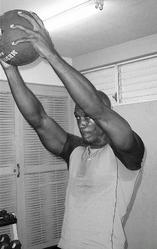
Kenneth Gardner
Regular appropriate exercise is safe and beneficial for many individuals with chronic conditions or other health concerns. Individuals who suffer form hypertension or heart disease, who exercise regularly, may lower their blood pressure and improve their cholesterol levels.
In the case of individuals with diabetes, regular physical activity and exercise will help to improve insulin sensitivity and body composition. Regular exercise is also important for individuals with asthma as it helps to reduce the risk of acute attacks during exertion. In general, individuals with special health concerns who are not participating in regular physical activity or exercising are at greater health risk than those associated with a moderate programme of regular exercise.
Here are some exercise recommendations for individuals with special health concerns and for the general public:
ASTHMA
Exercise regularly. Acute attacks are more likely if you exercise only occasionally.
Always carry medication during workouts and try to avoid exercising alone.
Warm up and cool down slowly to reduce the risk of acute attacks.
Cold dry air can trigger or worsen an attack. Drink water before, during and after a workout to moisten your airways. In cold weather, cover your mouth with a mask to warm and humidify the air you breathe.
Avoid outdoor activities during pollen season or when the air is polluted. Avoid exercising in dry or dusty indoor environment.
When starting an exercise programme, choose self pace endurance activities especially those involving interval training (short bouts of exercise followed by a rest period).
OBESITY
For maximum benefits and minimum risk choose low to moderate intensity activities.
Choose non- or low-weight bearing activities such as swimming, water exercise, cycling or walking. Low impact activities are less likely to lead to joint problems or injuries.
Ease into an exercise programme and increase overload gradually. Increase duration and frequency of exercise before increasing intensity.
Include strength training in your fitness programme to build or maintain fat-free mass.
OSTEOPOROSIS
For cardio-respiratory endurance activities, exercise at the maximum intensity that causes no significant discomfort. If possible, choose low-impact, weight-bearing activities to help safely maintain bone density.
Include weight training in your exercise programme to improve strength and balance and reduce the risk of falls and fractures. Avoid lifting heavy loads.
To prevent fractures, avoid activity or movements that stress your back or carry a risk of falling.
PREGNANCY
Exercising during pregnancy has several benefits but women should be careful because some types of exercise can pose increased risks to the mother and the unborn child. The following recommendations should be observed:
Have a physical done by your physician before you begin an exercise programme.
Do mild to moderate exercise routine at least three times a week. Avoid exercising vigorously or to exhaustion, especially in the third trimester.
Favour non- or low-weight bearing exercises such as swimming and walking over weight bearing exercise.
Avoid exercises that could cause loss of balance and exercises that might injure the abdomen, stress the joints, or carry a risk of falling (such as contact sports and racquet sports).
Avoid exercising in a supine position (lying on your back). Research indicates that this position restricts blood flow to the uterus. Also avoid prolonged periods of motionless standing.
Ensure that you drink plenty of fluids and exercise in well-ventilated areas to avoid heat stress.
After giving birth, resume pre-pregnancy routines gradually, based on how you feel.

Fully extend the arms in this lift. This exercise can also be done without any weights in your hands. - Daviot Kelly/Staff Reporter
Kenneth Gardner is an exercise physiologist at the G. C. Foster College of Physical Education: email: yourhealth@gleanerjm.com.
